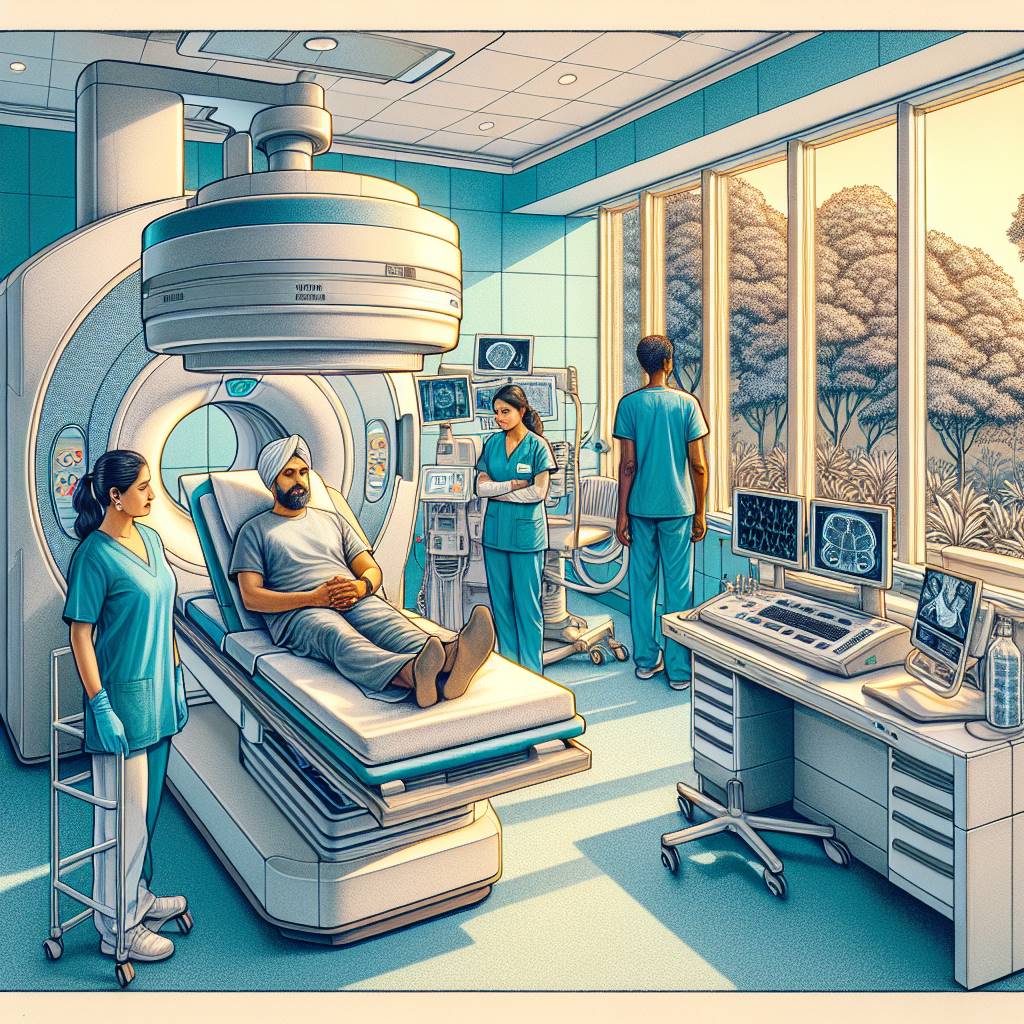PRRT (Lu-177 DOTATATE) is an advanced nuclear medicine therapy used to treat neuroendocrine tumors. In India, the cost typically ranges from ₹8–12 lakh per cycle, depending on the hospital and patient-specific factors. Eligibility is determined based on tumor type and receptor status, assessed via diagnostic imaging. Leading hospitals in cities like Mumbai, Delhi, and Bengaluru offer this treatment with experienced specialists and state-of-the-art facilities.
At a Glance: Key Takeaways About PRRT in India
PRRT with Lu-177 DOTATATE is a targeted therapy for neuroendocrine tumors (NETs), offering a precise approach with fewer side effects compared to traditional treatments. India provides this advanced therapy at significantly lower costs than many Western countries, making it an attractive option for medical travelers.

- Choose PRRT if you have advanced or inoperable NETs.
- Consider India for cost-effective, high-quality care.
- Opt for this therapy when other treatments fail.
- Ensure eligibility through somatostatin receptor imaging.
- Discuss risks like mild nausea or fatigue with your doctor.
Costs & Factors: Typical Ranges
What Influences PRRT Costs in India?
PRRT costs in India depend on factors like the hospital’s location, the expertise of the medical team, and the number of treatment cycles required. Each cycle typically costs ₹1,80,000–₹3,60,000 (≈ $2,150–$4,350 USD), with most patients needing 3–4 cycles. Additional costs may include diagnostic imaging and follow-up care.
Average Pricing Across Major Cities
In cities like Mumbai, Delhi, and Bengaluru, PRRT costs are competitive, ranging from ₹2,00,000 to ₹3,50,000 per cycle. Smaller cities may offer slightly lower prices, but availability of advanced facilities might be limited. Always confirm the total package cost, including hospital stay and supportive care.
Hidden Costs to Be Aware Of
Patients should budget for hidden costs such as pre-treatment imaging (₹20,000–₹50,000), hospital stays, and post-treatment monitoring. Travel and accommodation expenses for out-of-city patients can also add up. Discuss all potential charges upfront to avoid surprises.
How It Works: Steps & Workflow
Initial Consultation and Diagnosis
The process begins with a detailed consultation, including somatostatin receptor imaging (e.g., PET-CT) to confirm eligibility. Blood tests and scans are conducted to assess tumor spread and overall health. This ensures the treatment is tailored to your specific condition.
Administering Lu-177 DOTATATE
During the procedure, Lu-177 DOTATATE is injected intravenously. The radioactive compound binds to tumor cells, delivering targeted radiation to shrink or control their growth. The session is typically painless and lasts a few hours, with minimal discomfort.
Post-Treatment Monitoring
After each cycle, patients undergo follow-up imaging and blood tests to evaluate the treatment’s effectiveness. Common side effects like mild nausea or fatigue are monitored, and supportive care is provided as needed. Regular reviews help adjust the treatment plan if necessary.
Who It’s For: Eligibility & When to Choose It
PRRT is designed for patients with advanced or metastatic neuroendocrine tumors (NETs) that express somatostatin receptors. It is especially beneficial for those who have not responded to surgery, chemotherapy, or other treatments. Eligibility is confirmed through receptor imaging, ensuring the therapy targets the right cells.
This treatment is ideal for patients seeking a less invasive option with fewer side effects compared to traditional therapies. However, it may not be suitable for individuals with severe kidney or bone marrow issues. Always consult your oncologist to determine if PRRT is the right choice for your condition.
- Best for advanced or inoperable NETs.
- Requires somatostatin receptor positivity.
- Not recommended for severe organ dysfunction.
- Discuss risks and benefits with your doctor.
Benefits & Risks: What to Expect
Key Benefits of PRRT
Peptide Receptor Radionuclide Therapy (PRRT) is a targeted treatment for neuroendocrine tumors (NETs). It delivers radiation directly to cancer cells while sparing healthy tissues, which can result in fewer side effects compared to traditional therapies. PRRT may improve symptoms like flushing and diarrhea, and in some cases, it can slow tumor progression or shrink tumors, enhancing quality of life.
Potential Risks and Side Effects
While PRRT is generally well-tolerated, it may cause side effects such as nausea, fatigue, or mild blood count changes. Rarely, kidney or liver function may be affected, requiring close monitoring. Long-term risks, though uncommon, include secondary cancers or bone marrow suppression. Discussing these risks with your doctor ensures informed decision-making.
Timeline & Aftercare: First 4–12 Weeks
The first 4–12 weeks after PRRT are crucial for recovery and monitoring. Patients may experience mild fatigue or nausea, which typically resolve within days. Regular follow-ups, including blood tests, are essential to monitor kidney function, blood counts, and tumor response. Staying hydrated and maintaining a balanced diet can aid recovery.
Patients are advised to avoid close contact with pregnant women and children for a few days due to residual radiation. Long-term care may include periodic imaging to assess treatment efficacy. Adhering to your doctor’s recommendations ensures optimal outcomes.
- Hydrate well to support kidney function.
- Attend all scheduled follow-ups.
- Report unusual symptoms promptly.
Alternatives & When They Fit Better
Other Treatment Options for Neuroendocrine Tumors
Alternatives to PRRT include surgery, chemotherapy, and targeted therapies like somatostatin analogs. Surgery is often the first-line option for localized tumors, while chemotherapy may be used for aggressive or widespread disease. Somatostatin analogs help control symptoms and slow tumor growth in certain cases.
When PRRT May Not Be Suitable
PRRT may not be ideal for patients with poor kidney or bone marrow function, as these organs are sensitive to radiation. It is also less effective for tumors lacking somatostatin receptors. In such cases, other treatments like systemic chemotherapy or immunotherapy may be recommended.
How to Choose the Right Provider
Choosing the right provider for PRRT involves evaluating their expertise, facilities, and success rates. Look for centers with experienced nuclear medicine specialists and access to advanced imaging technologies. Accredited hospitals with a strong track record in treating neuroendocrine tumors are ideal.
- Verify the provider’s experience with PRRT.
- Ensure access to multidisciplinary care teams.
- Check patient reviews and success stories.
Latest Updates & What’s Changing
PRRT (Peptide Receptor Radionuclide Therapy) using Lu-177 DOTATATE is increasingly accessible in India due to advancements in nuclear medicine. This therapy is primarily used for treating neuroendocrine tumors (NETs) and has shown promising results in improving survival rates. Recent updates include enhanced imaging techniques for better tumor targeting and expanded eligibility criteria for patients with advanced-stage NETs.

- New imaging tools improve precision.
- Eligibility now includes more advanced NET cases.
- Better availability across top-tier Indian hospitals.
Key Differences: Side-by-Side
Who Is a Good Fit?
PRRT is ideal for patients with inoperable or metastatic neuroendocrine tumors that express somatostatin receptors. Candidates typically undergo a PET-CT scan to confirm receptor positivity. Patients with good kidney function and manageable tumor burden are better suited for this therapy. However, those with severe organ dysfunction or non-receptor-positive tumors may not qualify.
Performance & Outcomes
PRRT has shown significant efficacy in reducing tumor size and controlling symptoms in NET patients. Studies indicate that it can extend progression-free survival by up to 40 months in eligible cases. While outcomes vary, most patients experience improved quality of life and symptom relief. Regular follow-ups are essential to monitor long-term benefits and side effects.
Cost & Ongoing Needs
The cost of PRRT in India ranges from ₹8,00,000–₹12,00,000 (≈ $9,650–$14,500 USD) for a full treatment cycle. This includes imaging, therapy sessions, and supportive care. Post-treatment, patients may require periodic scans and blood tests, adding to ongoing expenses. Financial assistance programs are available at select hospitals to support eligible patients.
| Dimension |
Eligible Patients |
Ineligible Patients |
| Candidacy |
Somatostatin receptor-positive NETs |
Receptor-negative or severe organ damage |
| Durability |
Progression-free survival up to 40 months |
Limited or no benefit |
| Medications |
Minimal post-therapy drugs |
Higher reliance on alternative treatments |
| Recovery Time |
Outpatient; minimal downtime |
Not applicable |
| Cost |
₹8,00,000–₹12,00,000 |
Not applicable |
Top Hospitals for PRRT in India
India is home to several leading hospitals offering PRRT with Lu-177 DOTATATE, equipped with advanced nuclear medicine facilities. These centers have experienced oncologists and nuclear medicine specialists who ensure precise and safe treatment. Popular cities for PRRT include Mumbai, Delhi, and Bengaluru, known for their state-of-the-art healthcare infrastructure.

- Tata Memorial Hospital, Mumbai
- AIIMS, New Delhi
- Manipal Hospital, Bengaluru
- Fortis Memorial Research Institute, Gurgaon
- Christian Medical College, Vellore
Preparing for PRRT Treatment
Preparation for PRRT involves a thorough evaluation by a nuclear medicine specialist. Patients undergo diagnostic tests, including PET-CT scans, to confirm somatostatin receptor positivity. Blood tests are also conducted to assess kidney and liver function, as these organs play a crucial role in processing the radioactive material.
Patients are advised to stay hydrated and avoid certain medications that may interfere with the therapy. A detailed consultation helps address concerns and set realistic expectations. Pre-treatment counseling ensures patients are well-informed about the procedure and potential side effects.
- Complete PET-CT and blood tests.
- Discuss medical history with your doctor.
- Follow hydration and dietary guidelines.
- Understand post-treatment care requirements.
Long-Term Outcomes and Survival Rates
PRRT with Lu-177 DOTATATE has shown promising long-term outcomes for patients with neuroendocrine tumors (NETs). Studies indicate that it can improve progression-free survival and overall quality of life, particularly in cases where other treatments have failed. While individual results may vary, many patients experience a significant reduction in tumor size and symptoms.

- Improves progression-free survival in advanced NETs.
- May reduce tumor size in responsive cases.
- Enhances quality of life for eligible patients.
- Long-term benefits depend on tumor type and stage.
Common Questions About PRRT
Patients often ask about the safety and effectiveness of PRRT. This therapy is generally well-tolerated, with mild side effects like nausea or fatigue. Serious complications are rare but may include kidney or bone marrow issues. Another common question is about eligibility—PRRT is typically recommended for patients with somatostatin receptor-positive NETs that have not responded to other treatments.
- Is PRRT safe? Yes, with minimal side effects for most patients.
- Who qualifies? Those with somatostatin receptor-positive NETs.
- How effective is it? It can significantly improve symptoms and tumor control.
- What are the risks? Rare kidney or bone marrow complications.
Patient Experiences and Testimonials
Many patients undergoing PRRT report positive experiences, including symptom relief and improved quality of life. Testimonials often highlight the professionalism of medical teams in India and the affordability of treatment compared to other countries. Patients also appreciate the personalized care and follow-up provided by top hospitals specializing in PRRT.

- “I felt better within weeks of starting PRRT.”
- “The care team was incredibly supportive throughout my treatment.”
- “Choosing PRRT in India was both effective and affordable.”
- “My symptoms have significantly reduced, and I feel hopeful again.”
Future Research and Developments
Ongoing research aims to enhance PRRT’s effectiveness and expand its applications. New isotopes and combination therapies are being explored to improve outcomes for patients with advanced or resistant NETs. Additionally, studies are focusing on minimizing side effects and personalizing treatment protocols based on genetic profiling.

- Development of new isotopes for better targeting.
- Combination therapies to enhance treatment response.
- Research on reducing side effects for long-term safety.
- Personalized approaches using genetic profiling.
Frequently Asked Questions About PRRT (Lu-177 DOTATATE) in India: Costs, Eligibility & Top Hospitals
What is PRRT and how does it work?
PRRT, or Peptide Receptor Radionuclide Therapy, uses radioactive molecules to target and destroy cancer cells in neuroendocrine tumors. It works by binding to specific receptors on tumor cells and delivering radiation directly to them, minimizing damage to healthy tissues.
Who is eligible for PRRT treatment?
Patients with advanced neuroendocrine tumors that express somatostatin receptors are typically eligible for PRRT. Eligibility is determined through specific imaging tests and medical evaluation to ensure the treatment is suitable and effective for the individual.
What are the typical costs of PRRT in India?
The cost of PRRT in India usually ranges between ₹8–15 lakhs per cycle, depending on the hospital and patient needs. This includes the cost of the radioactive material, hospital stay, and associated medical care.
Are there any risks or side effects of PRRT?
PRRT is generally safe but may cause side effects like nausea, fatigue, or mild blood count changes. Rarely, kidney or bone marrow function may be affected, so regular monitoring is essential during and after treatment.
How long does the PRRT treatment process take?
Each PRRT session typically lasts 4–6 hours, including preparation and observation time. The full treatment usually involves 3–4 cycles, spaced 6–8 weeks apart, depending on the patient’s response and medical condition.
What are the alternatives to PRRT?
Alternatives to PRRT include surgery, chemotherapy, targeted therapies, and somatostatin analogs. The choice depends on the tumor type, stage, and patient health, and should be discussed with an oncologist.
Which hospitals in India offer PRRT?
Leading hospitals in India offering PRRT include specialized cancer centers in cities like Mumbai, Delhi, Bengaluru, and Chennai. These facilities have experienced nuclear medicine teams and advanced infrastructure for the treatment.
What should I expect during post-treatment care?
Post-treatment care involves regular follow-ups, blood tests, and imaging to monitor recovery and tumor response. Patients may need to manage mild side effects and maintain a healthy lifestyle to support overall well-being.
Discover the Best Oncologists and Cancer Hospitals in India
When it comes to cancer treatment, finding the right specialist and hospital can make a significant difference in the outcome. In this blog, we have compiled a list of the top oncologists and cancer hospitals across major cities in India, ensuring that you have access to the best care available.
Top Oncologists in Major Cities
For those seeking expert oncologists, we have identified the best specialists in key cities:
Leading Cancer Hospitals
In addition to finding the right specialist, choosing the right hospital is crucial for comprehensive cancer care. Here are the top hospitals in major cities:
Get more indepth information on Cancer treatments and their costs
Conclusion
Finding the right oncologist and hospital is the first step in your cancer treatment journey. Explore the links above to learn more about the top specialists and hospitals in your area.